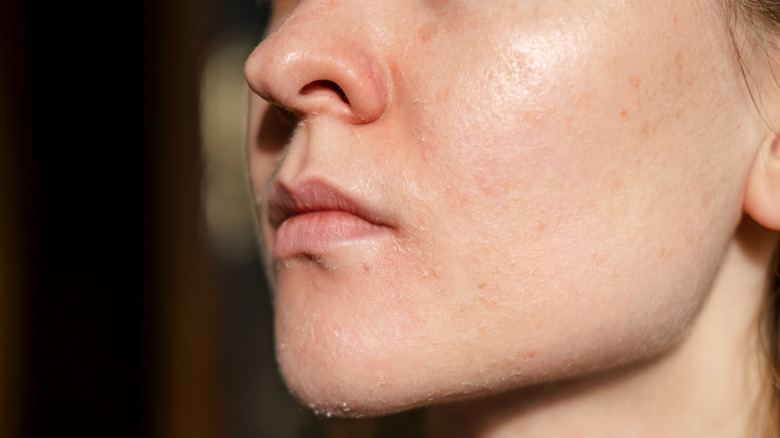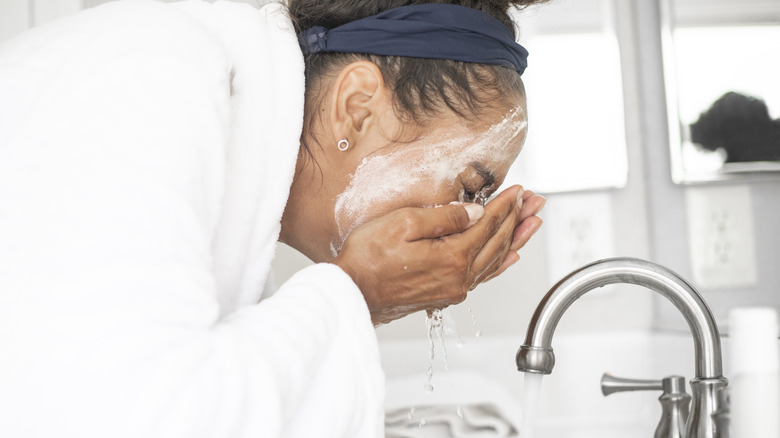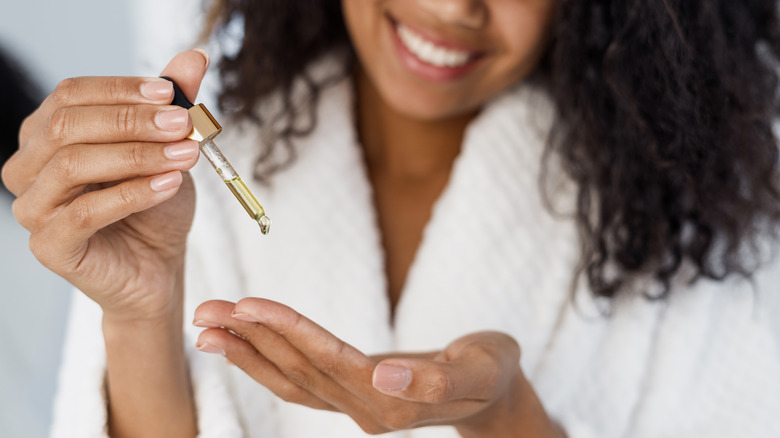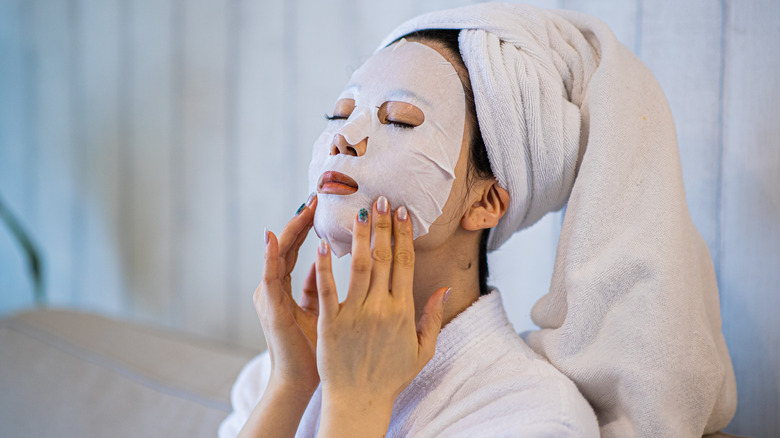The Top 5 Must-Have Skincare Ingredients For Dry Skin
Let's be honest: there's nothing worse than dry skin. Not only does dry skin look dull, ashy, and sometimes irritated, but it can feel itchy and tight too. Although some people are more susceptible to dry skin than others, it can happen to anyone. Sometimes it's a matter of genetics, while other times we can point a finger at environmental causes, bad habits, or the simple fact that we're aging. Luckily, regardless of the cause, dry skin can be remedied. It all comes down to using the right ingredients.
"The best moisturizing cream for dry skin will have a combination of emollients, humectants, and occlusives," board-certified dermatologist Corey L. Hartman, MD told Byrdie. Emollients consist of ingredients that dive right in through the skin barrier to moisturize, humectants attract water to the skin to keep it hydrated, and occlusives lock it all in. But while ingredients that have these three properties are pretty much the winning ticket when it comes to fighting and preventing dry skin, some elements are more powerful than others. In other words, there are five must-have skincare ingredients that everyone with dry skin should know about.
Hyaluronic acid
When it comes to hydrating the skin, we hear a lot about hyaluronic acid because it truly is the best for staving off dryness. "[Hyaluronic acid is] a water-holding gel with the ability to hold 1,000 times its own weight in moisture," dermatologist Dr. Sam Bunting told Stylist. "When it's applied topically, skin acts as a highly effective barrier and those hyaluronic acid molecules are too big to squeeze through the dermis (the layer of skin beneath the epidermis), which is where it needs to be to help plump lines and wrinkles."
Because it can't penetrate the skin, hyaluronic acid makes for the ideal humectant. It basically just sits there, sucking water in from anywhere it can so the skin is optimally hydrated. When you have this level of hydration going on 24/7, skin doesn't just look healthy and radiant (read: it actually glows!), but it feels amazing too. Hyaluronic acid can be found in cleansers, serums, and moisturizers. So how you choose to include it in your skincare routine is up to you.
Ceramides
If you see a skincare product that lists ceramides on its packaging, especially toward the top of the list, pick it up immediately. These are lipids (emollients) that account for 50% of the outer layer of skin, meaning they're essential in keeping the skin's barrier healthy and working at its strongest capacity. "Ceramides are essentially the glue that holds our skin cells together to form a healthy skin barrier," dermatology physician assistant Clara Wilson, MS, PA-C told Cleveland Clinic.
But as necessary as they are in protecting the skin from harmful things like pollution, allergens, and other potential irritants, when we get older these lipids struggle to naturally replenish themselves in a timely manner, if at all. Because of this, it's important to use moisturizers, like serums and face lotions, with ceramides in them so those lipid levels are kept top-notch. CeraVe and Cetaphil are both perfect examples of well-known name brands that contain ceramides.
Glycerin
Like hyaluronic acid, glycerin is also a humectant, making it an essential ingredient in preventing dry skin. "The ingredient can reach down to the dermis layer of the skin and bring moisture up so that the skin can plump and hydrate itself from within," board-certified dermatologist Elizabeth Houshmand told Harper's Bazaar. It also attracts water from the air which can diminish the appearance of fine lines, thanks to the plumpness it promotes due to its low molecular weight.
When incorporating glycerin into your skincare routine, look for it in serums and moisturizers. It's powerful, so you don't need an extra high concentration of it, but you still want it to be listed as one of the first few ingredients on the packaging. "For ingredient lists on skincare products, the ingredients are listed from highest to lowest concentration," board-certified dermatologist Dr. Ramya Garlapati told CNN. "So if glycerin is one of the first few ingredients listed, it's safe to say the product has a high concentration of it, making it a hydrating product."
Squalane
According to a 2016 study published in the Indian Journal of Dermatology, squalane (an emollient) is squalene (note the slight difference in spelling there) in its most saturated form. It's an important restorative ingredient because it protects the skin from UV rays and similar types of ionizing radiation that can cause skin damage. Squalane is also a major component in sebum, which is the skin's natural occlusive because it's an oily barrier that works to maintain hydration levels. In other words, squalane does double duty acting as both an emollient and occlusive.
"So when you put it on, you're not only preventing water loss, you're also helping to protect the skin from harsh stuff in the environment," board-certified dermatologist Loretta Ciraldo, M.D., F.A.A.D told Good Housekeeping. When it comes to incorporating it into your skincare routine, Ciraldo recommends squalane be used twice a day in oil form, after cleansing and serums, but before moisturizing.
Lactic acid
One of the most important things when fighting dry skin is to get rid of that dead skin that's accumulated — there's no sense in holding on to it, after all. This is where lactic acid comes in as a major player. "Lactic acid is an alpha-hydroxy acid that comes from the fermentation of lactose, a sugar naturally found in milk," board-certified dermatologist Margarita Lolis, MD told Self. "Lactic acid works by loosening the 'glue' that holds skin cells together, encouraging exfoliation of the dead skin cells and increasing cell turnover."
According to a 2014 study published in Clinical, Cosmetic and Investigational Dermatology, alpha hydroxy acids like lactic acid improve the skin's elasticity and texture, as well as aid in diminishing the appearance of fine lines and wrinkles. Although lactic acid can be found in night creams, the easiest way to make it part of your routine is by using cleansers, peels, and/or masks that contain it.
As much as these five ingredients are must-haves for dry skin, if you're unfamiliar with any of them, talk to your doctor first. Allergic reactions are always a possibility when trying something new on your skin.





